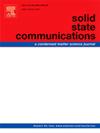Effects of the electron-doping on the structural and magnetic properties of the Sr2−xCexFe1+x/2Mo1−x/2O6 double perovskite
IF 2.4
4区 物理与天体物理
Q3 PHYSICS, CONDENSED MATTER
引用次数: 0
Abstract
We report the structural, magnetic and magneto-transport properties of the new Ce-doped double perovskite SrCeFeMoO6 series with , obtained by solid state reaction. The chemically homogeneous samples show a tetragonal to monoclinic crystallographic phase transition starting at 0.3 and ending at 0.35, which was confirmed by X-ray diffraction measurements and Rietveld refinements. The Curie temperature T determined by magnetic susceptibility experiments, shows an initial decrease between the un-doped sample and 0.05, followed by a general increase with doping, reaching a T 427 K for 0.5. A particular behavior close to the structural transition is observed. The electrical behavior is characterized by a rapid drop of the magnetoresistance ratio and a slight increase at small values of x attributable to electron injection, followed by a general decrease due principally to a controlled antisite disorder.
电子掺杂对Sr2−xCexFe1+x/2Mo1−x/2O6双钙钛矿结构和磁性能的影响
本文报道了采用固相反应法制备的新型掺铈双钙钛矿Sr2−xCexFe1+x/2Mo1−x/2O6系列(0.0≤x≤0.5)的结构、磁性和磁输运性质。在x射线衍射测量和Rietveld细化中,均相样品显示出从x= 0.3开始到x= 0.35结束的四方到单斜晶体相变。磁化率实验测得的居里温度TC在x= 0.05时呈下降趋势,在x= 0.5时呈上升趋势,达到427 K。观察到一种接近结构转变的特殊行为。电学行为的特点是磁阻比迅速下降,在x的小值处,由于电子注入,磁阻比略有增加,然后主要由于控制的反位紊乱而普遍下降。
本文章由计算机程序翻译,如有差异,请以英文原文为准。
求助全文
约1分钟内获得全文
求助全文
来源期刊

Solid State Communications
物理-物理:凝聚态物理
CiteScore
3.40
自引率
4.80%
发文量
287
审稿时长
51 days
期刊介绍:
Solid State Communications is an international medium for the publication of short communications and original research articles on significant developments in condensed matter science, giving scientists immediate access to important, recently completed work. The journal publishes original experimental and theoretical research on the physical and chemical properties of solids and other condensed systems and also on their preparation. The submission of manuscripts reporting research on the basic physics of materials science and devices, as well as of state-of-the-art microstructures and nanostructures, is encouraged.
A coherent quantitative treatment emphasizing new physics is expected rather than a simple accumulation of experimental data. Consistent with these aims, the short communications should be kept concise and short, usually not longer than six printed pages. The number of figures and tables should also be kept to a minimum. Solid State Communications now also welcomes original research articles without length restrictions.
The Fast-Track section of Solid State Communications is the venue for very rapid publication of short communications on significant developments in condensed matter science. The goal is to offer the broad condensed matter community quick and immediate access to publish recently completed papers in research areas that are rapidly evolving and in which there are developments with great potential impact.
 求助内容:
求助内容: 应助结果提醒方式:
应助结果提醒方式:


